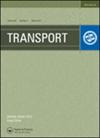CONTROL STRATEGY FOR A NON-HYBRID HYDROSTATIC TRANSMISSION CONSTRUCTION VEHICLE BASED ON POWER FOLLOWER
IF 1.3
4区 工程技术
Q3 TRANSPORTATION SCIENCE & TECHNOLOGY
引用次数: 0
Abstract
To achieve energy-saving control of non-hybrid Hydrostatic Transmission Construction Vehicles (HST-CVs) with traditional closed-loop Hydrostatic Transmission (HST) for both propulsion and working systems, this paper presents a control strategy for non-hybrid HST-CVs by referring to the power follower method of the hybrid Energy Management Strategy (EMS). Through the implementation of the presented control strategy by coordinated control of the engine speed and hydraulic pump displacement, the engine can be controlled to operate at the pre-set low Brake Specific Fuel Consumption (BSFC) area, similar to that of the hybrid vehicles adopting a power follower control strategy but without the additional installation of accumulators in the hydraulic system. The effect of the control strategy is verified via experimental tests and MATLAB/SIMULINK–AMESIM COLlaborative SIMulation (COSIM). The simulation results show that the proposed control strategy can achieve the expected control target under both highway and off-road conditions.基于动力跟随器的非混合动力静压传动工程车控制策略
为实现推进系统和工作系统均采用传统闭环静压传动的非混合动力工程车辆(HST- cv)的节能控制,借鉴混合动力能量管理策略(EMS)中的功率跟随器方法,提出了一种非混合动力工程车辆的控制策略。通过对发动机转速和液压泵排量进行协调控制的控制策略,可以将发动机控制在预先设定的低制动比油耗(BSFC)区域,类似于采用动力随动器控制策略的混合动力汽车,但无需在液压系统中额外安装蓄能器。通过实验测试和MATLAB/ SIMULINK-AMESIM协同仿真(COSIM)验证了控制策略的效果。仿真结果表明,所提出的控制策略在公路和非公路工况下均能达到预期的控制目标。
本文章由计算机程序翻译,如有差异,请以英文原文为准。
求助全文
约1分钟内获得全文
求助全文
来源期刊

Transport
Engineering-Mechanical Engineering
CiteScore
3.40
自引率
5.90%
发文量
19
审稿时长
4 months
期刊介绍:
At present, transport is one of the key branches playing a crucial role in the development of economy. Reliable and properly organized transport services are required for a professional performance of industry, construction and agriculture. The public mood and efficiency of work also largely depend on the valuable functions of a carefully chosen transport system. A steady increase in transportation is accompanied by growing demands for a higher quality of transport services and optimum efficiency of transport performance. Currently, joint efforts taken by the transport experts and governing institutions of the country are required to develop and enhance the performance of the national transport system conducting theoretical and empirical research.
TRANSPORT is an international peer-reviewed journal covering main aspects of transport and providing a source of information for the engineer and the applied scientist.
The journal TRANSPORT publishes articles in the fields of:
transport policy;
fundamentals of the transport system;
technology for carrying passengers and freight using road, railway, inland waterways, sea and air transport;
technology for multimodal transportation and logistics;
loading technology;
roads, railways;
airports, ports, transport terminals;
traffic safety and environment protection;
design, manufacture and exploitation of motor vehicles;
pipeline transport;
transport energetics;
fuels, lubricants and maintenance materials;
teamwork of customs and transport;
transport information technologies;
transport economics and management;
transport standards;
transport educology and history, etc.
 求助内容:
求助内容: 应助结果提醒方式:
应助结果提醒方式:


